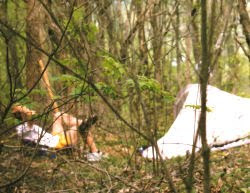 Bill Zimmerman and Jersey |
from the Central New York Chapter newsletter, May 2011, by Bill Zimmerman
Anyone who worked on convertng the LVRR former rail-bed, which had been abandoned for 40+ years, to a fine trail from Nelson Road West to Cottons Crossing, [near Cazenovia, NY] will remember the tangled mess of grapevines, downed trees and honeysuckle bushes. Work was slow, as the narrow path was cut into the thick brush and only a few volunteers could cut at the lead with others passing the cut brush to the rear. Other folks worked on finding and clearing places to pile cut brush off to the side.
Today, this trail winds gently and is still very narrow, meandering along the Canastota Creek. With much of it barely four feet wide, it doesn’t have the appearance of an old railroad bed. To begin with, the new trail was rough and needing improvements to the walking surface including removing stumps, surface vines and some fallen trees. People have been slow to find this trail but usage is steadily increasing in number including hikers, dog walkers, cross country skiers and even some horses.
Horses are not authorized for the trail because it is very narrow and the walking surface can’t support them. This past year, I requested, received, and put up a trail register box which is about 100 yards West of Nelson Road. It was exciting to see an entry the same day the box was installed. Most entries are just a date and name but some are interesting.
Even though Jersey and I walk this trail almost every day, the new register shows more folks are using it than what we have seen or thought. The trail register is a good tool to gauge the usage of a trail. So if you want a different hiking experience, please come to Nelson Road West-Cottons Crossing. Parking is available at both trailheads.
See Central New York Chapter of the NCTA































